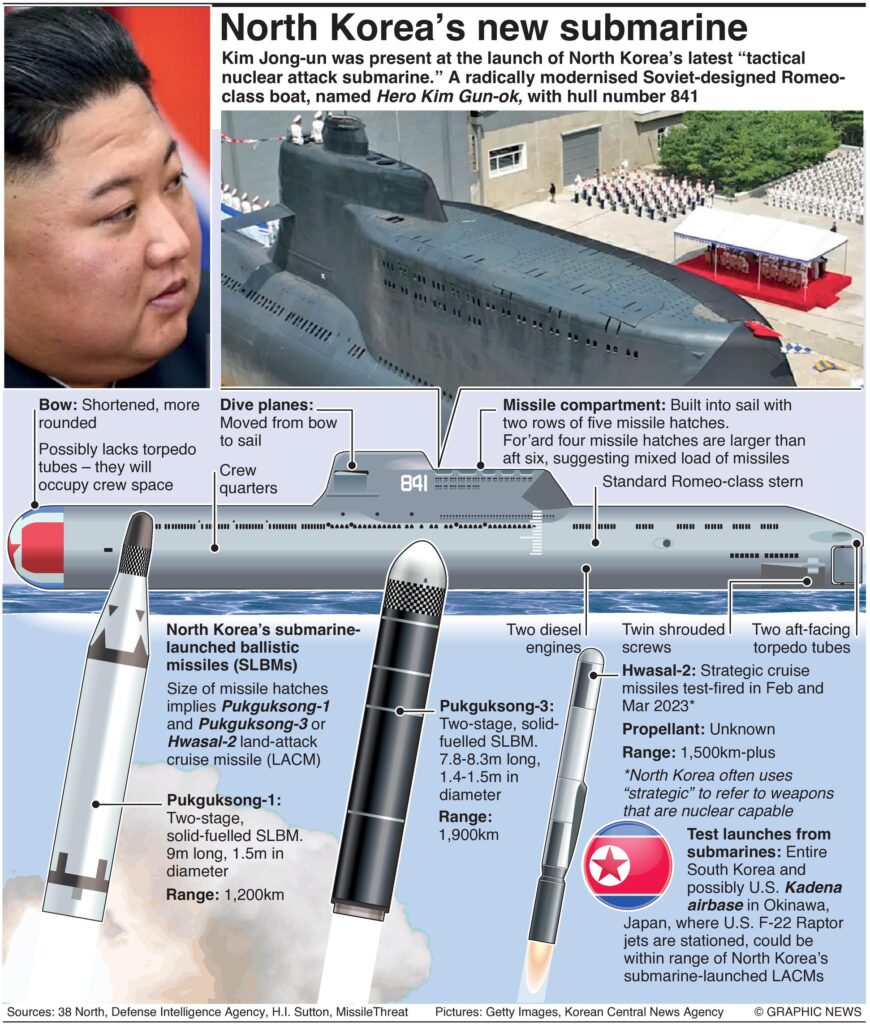ANALYSIS – Kim Jong-un, wearing a light-colored suit and silly-looking wide-brimmed hat, was present at the launch of North Korea's first “tactical nuclear attack submarine.”
The boat is a radically modernized old Soviet-designed Romeo-class boat named Hero Kim Gun-ok, with hull number 841.
This comes after reports of North Korea building a nuclear-armed torpedo able to level coastal cities. I wrote about that monster here.
There is still no known submarine that can carry that nuke torpedo, which would likely be delivered from a barge or coastal base.
But now, this diesel-electric-powered missile submarine was unveiled and launched at a ceremony on September 6 at the Sinpo submarine yard on North Korea's eastern shore. (RELATED: US Soldier Laughed While Defecting To North Korea: Report)
The BBC quoted Kim as saying that the sub will be one of the navy's main means of “underwater offensive.”
“The nuclear attack submarine, which has been a symbol of aggression against our nation for the past few decades, now symbolizes our threatening power that strikes fear into our unscrupulous enemies,” Kim added.
Although it will carry nuclear warheads, this is technically not a “nuclear submarine,” which refers to the propulsion system.
Naval expert H I Sutton provided excellent reporting on this sub-launch. (RELATED: Biden Publicly Announcing Nuclear Missile Submarine Visits)
The submarine appears to have had its bow crudely cut off and capped, while the aft section remains unchanged. This boat may be the same one seen in July 2019 – the so-called Gorae/Sinpo-C version of a Romeo-class submarine.
Sutton noted that:
The modification to the Romeo class submarine is so extensive that it almost appears to be a new boat. The new missile compartment, with two rows of five missile hatches, is in a section built into the sail. The bow has been shortened, reshaped and the diving planes moved to the sail.

Significantly, the submarine has a missile compartment added with ten missile tubes. Given the North's investment in ballistic missiles and rampant recent testing, it is highly likely that these weapons are nuclear-capable.
The forward four hatches are larger than the aft six, suggesting that the boat will carry multiple types of missiles – a mix of short-range and longer-range submarine-launched ballistic missiles (SLBMs) and land-attack cruise missiles (LACMs).
In particular, the new nuclear-capable cruise missile, the Hwasal-2, was adapted for submarine launch. The Hwasal-2 is outwardly similar to the U.S. Navy's Tomahawk cruise missile.
H I Sutton wrote in Naval News: “One hypothesis is that the first Romeo submarine conversion, armed with three Pukguksong missiles, was not successful. And that this boat represents the latest thinking, emphasizing more yet smaller missiles.”
Still, other naval experts aren't impressed.
The BBC reported:
“As a platform, it will have some fundamental limitations and vulnerabilities,” said Joseph Dempsey, a researcher at the International Institute for Strategic Studies.
These include being noisy, slow and having limited range, according to Vann Van Diepen, a former US government weapons expert, who spoke to Reuters news agency.
While the modified sub likely won't be able to stay underwater very long, or travel very far, its targets will be mostly U.S. and South Korean bases in the South, or nearby U.S. bases in Japan, or Guam.
Since the weapons deployed by the sub will be at least low-yield nukes, just having one or two reach their targets could be enough.
The opinions expressed in this article are those of the author and do not necessarily reflect the positions of American Liberty News.
READ NEXT: Undercover Video Reveals The Newest Trojan Horse In Education



The only sane thing to do would be to keep track of it, and sink it the first time it leaves sport.
Can we find & sink sub
ABSOLUTELY!!!